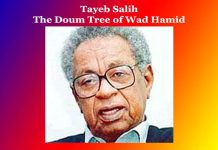Izz al-din al-Madani | The Tale of the Lamp
Izz al-din al-Madani The Tale of the Lamp
Izz al-din al-Madani’s Short Story ‘The Tale of the Lamp’ — An Analytical Study
‘The Tale of the Lamp’ is an Arabic short story written by Izz al-Din al-Madani (1938-), a Tunisian novelist, story-teller, essayist and critic. It is a short story of the ancient ‘tale’ kind. Poverty and craving for money is the main theme of the story. The short gives us a picture of the middle ages, especially of Baghdad during the Sultanate’s reign.
Through the story, the author has portrayed a clever man who lived amid opulence and believed that contentment was an everlasting treasure. He was a cobbler and repaired shoes in his shop at day time and at night he kept busy with his family and lived a happy life. But unfortunately, a famine broke out in the land and people had to spend days after days without food. He also spent out all his treasures and had run out of food. He flew into a wild rage. One day he came out of his home armed with a knife in search of food for his family. He thought if needed he would steal or kill people to have food for his family. On the way, he saw people piled up along the street. The sun’s heat was very scorching. He found nothing and returned home with some wax in his bag. Then he went to his shop, took a large sack and filled it with everything he had: sewing needle, thread, some nails, a hammer, knife, and the lamp that hung from the ceiling.
He walked ahead and crossed deserts, wastelands, and oases encountering neither flowers nor animals. The man continued his journey, despite severe hunger, thirst and fatigue. After some days, on a crystal-clear night, the traveller reached the walls of a city made of red clay which has suddenly appeared in the bleak desert. He knocked at the gate and to his surprise, a guard appeared before him who said, ‘Welcome to the city of Timbuktu. You are among the brothers.’ The guard said, ‘Drink! However, one of the conditions of entry into the city is that you spend the night outside its walls. On the morrow, you enter, provided you have a gift for our ruler, the Sultan.’
The next morning the guard roused the man. The traveller performed his ablution and prayed in the mosque. After this, he was led to the palace. The Sultan greeted him warmly. The traveller was very agitated concerning the gift that he had to give to the Sultan. At last, he took out the lamp from his bag and presented it to the Sultan. After seeing the lamp, the Sultan became surprised and happy. The traveller explained the use of the lamp. The Sultan in gratitude wanted to make him a minister in his court. But the traveller said, ‘My lord, I am but a commoner, a God-fearing man, I enjoy peace and tranquillity and wouldn’t know how to advise a Sultan.’
Then the Sultan wedded the princess to the traveller. He began to stay there happily. The traveller made thousands of lamps for the Sultan, his courtiers and all the people. He hung them everywhere in the palace, the mosques, the schools, streets, squares and houses. He employed one thousand black men to light the lamp until the entire city and its inhabitants bathed in light night and day. He began to enjoy a life of comfort and happiness. Years passed on and one day he begged the permission of the Sultan to return to his native land. The Sultan agreed and he began to prepare a caravan of camels, horses, donkeys and mules carrying rugs from Kairouan, mastic from Yemen, teak from Niger, amber from Sudan, ivory from Ghana and other fineries.
When he arrived in his city people began crowding around him to grab his possession. Soon fights erupted over them and they even began to kill each other.
Then there came a man who was his neighbour and had a shop just opposite to the traveller’s shop. He was also a sandal maker. He asked about how he came by such riches. Then he told him about the land of the Sultan. As there was still famine the old man set out for the land of the Sultan to get his favour. He travelled a lot and at last, reached the city of the Sultan. The Sultan greeted him well. As a custom of the land, the old man gave the finest sandal to the Sultan as a gift. The Sultan was surprised and ordered his treasurer to bring a present for the man. The treasurer brought a lot of lucre (coins). But the Sultan said that the man’s gift was very wonderful so ‘he deserves a better reward than mere filthy lucre’ and presented him with the lamp that was given by the former traveller as a gift to the Sultan.
Thus the author has brought out the themes of poverty, and crave for wealth in the story.
There are three characters in the story. The first traveller is the main character. He is a very lucky man as he lived amid opulence and contentment with his wife, sons and daughters. He had a shop in the city and did the job of repairing shoes. He believed that contentment was an everlasting treasure. But when the catastrophe of famine broke out in the land then people began to die of hunger. The man also ran out of his food and became disappointed. At last, one day he went to the land of the Sultan where he met his luck. He was treated well there and the Sultan offered him the post of ministry in his court but he said that he was a commoner and he did not know how to advise a Sultan. Then the Sultan wedded him to the princess where he lived in comfort and happiness. After some years he returned to his native land with lots of riches. There are some individual traits in him as he is content and happy, he even intends to steal and kill to meet his need.
The Second traveller who was a cobbler is an unlucky man. He also experienced the severity of the famine. After hearing about the land of the Sultan he also went to the court of the Sultan with a hope to get his favour. The Sultan greeted him with love but he did not get any riches from the Sultan except the lamp which was gifted to the Sultan by the former traveller.
The third character is the Sultan. He is kindhearted and generous no doubt but he is devoid of common sense. He rewarded the former traveller much beyond he wished, but he showed no favour to the second traveller who was in dire need of wealth. The irony lies here in the story.
In narrating the story, the author has employed a descriptive method. He has narrated the story in the third person and portrayed his characters in his own way.
The structure of the story is coherent and logical. Though the exposition of the story is ancient tale-like yet the author succeeds in organically presenting the story. The climax of the story reaches when the traveller brings out the lamp as a gift to the Sultan. The rest is the denouement.
The Setting of the story is realistic and fascinating. The author gives a vivid picture of the effect of famine as he writes: ‘Food had run out and people went into the desert to look for cacti and grass to assuage their hunger after their hopes had been dashed, they preferred death over life.’ He also gives a vivid description of the traveling of the traveller through grass, wasteland, desert, and oasis.
The author has employed sparing dialogue in the story skillfully which has brought about the inner motives of the characters.
The Philosophy of life is also found in the story. The author has expressed his philosophy of life indirectly that good luck does not favour everybody. Royal favour is often illogical and is placed upon the wrong person.
The Language of the story ‘The Tale of the Lamp’ is simple and easy. It becomes fascinating as the author used some similes as:
‘His heart was throbbing like mad, the pulses reverberating like a drum.’
‘He is like a musk and amber, silk and velvet, like a flower and jasmine.’
In maintaining the Qualities of a good short story as —unity of purpose, brevity, spontaneity and universality the author has not succeeded to the real sense though the unity of purpose is maintained throughout the story.
Though there is almost all the features of a good story yet there is some elements of an ancient tale as the story begins as:
“Once upon a time, there was a man who lived in one of these ancient cities.”
To conclude it may be said that the story entitled, ‘The Tale of the Lamp’ by Al-Madani is a short story of ideal length dealing with the theme of poverty and craving for money, the characters of which are typed as well as individual, the setting realistic, the dialogue sparing, the language simple and well to read. 0 0 0
Izz al-din al-Madani ‘The Tale of the Lamp’
Books of Literary Criticism by M. Menonimus:
- World Short Story Criticism
- World Poetry Criticism
- World Drama Criticism
- World Novel Criticism
- World Essay Criticism
- Indian English Poetry Criticism
- Indian English Poets and Poetry Chief Features
- Emily Dickinson’s Poetry-A Thematic Study
- Walt Whitman’s Poetry-A Thematic Study
- Critical Essays on English Poetry
- Tawfiq al-Hakim’s Novel: Return of the Spirit-An Analytical Study
- Tawfiq al-Hakim’s Novel: ‘Yawmiyyat Naib Fil Arayaf’-An Analytical Study
- Analytical Studies of Some Arabic Short Stories
- A Brief History of Arabic Literature: Pre-Islamic Period (500 AD-622 AD)
- A Brief History of Arabic Literature: Early Islamic Period (622 AD-661 AD)
- Reviews on William Shakespeare’s Works
- Reviews of Charles Dickens’ Works
- Reviews of John Milton’s Literary Works
- Reviews of Some Iconic Travelogues
- Shakespeare’s Sonnets-Critical Studies
- Analytical Studies of Selected Poems of Sarojini Naidu
- Analytical Studies of Selected Poems of Rabindranath Tagore
- Analytical Studies of Selected Indian English Poems
- Reviews of Selected Motivational Books
- Origin Evolution & Functions of Literature
- Essays on Shakespeare and His Time …











